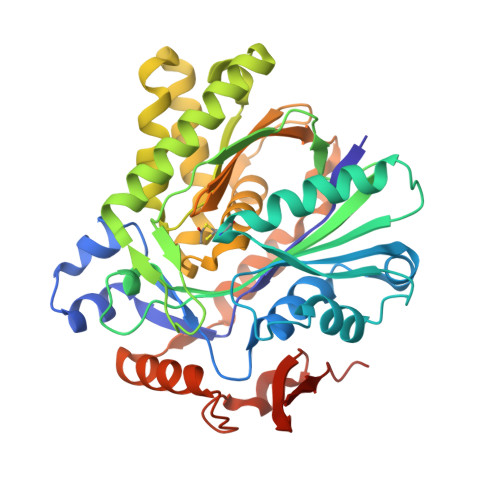3-hydroxy-3-methylglutaryl-CoA synthase intermediate complex observed in "real-time"
Theisen, M.J., Misra, I., Saadat, D., Campobasso, N., Miziorko, H.M., Harrison, D.H.T.(2004) Proc Natl Acad Sci U S A 47: 16442-16447
- PubMed: 15498869
- DOI: https://doi.org/10.1073/pnas.0405809101
- Primary Citation of Related Structures:
1XPK, 1XPL, 1XPM - PubMed Abstract:
The formation of carbon-carbon bonds via an acyl-enzyme intermediate plays a central role in fatty acid, polyketide, and isoprenoid biosynthesis. Uniquely among condensing enzymes, 3-hydroxy-3-methylglutaryl (HMG)-CoA synthase (HMGS) catalyzes the formation of a carbon-carbon bond by activating the methyl group of an acetylated cysteine. This reaction is essential in Gram-positive bacteria, and represents the first committed step in human cholesterol biosynthesis. Reaction kinetics, isotope exchange, and mass spectroscopy suggest surprisingly that HMGS is able to catalyze the "backwards" reaction in solution, where HMG-CoA is cleaved to form acetoacetyl-CoA (AcAc-CoA) and acetate. Here, we trap a complex of acetylated HMGS from Staphylococcus aureus and bound acetoacetyl-CoA by cryo-cooling enzyme crystals at three different times during the course of its back-reaction with its physiological product (HMG-CoA). This nonphysiological "backwards" reaction is used to understand the details of the physiological reaction with regards to individual residues involved in catalysis and substrate/product binding. The structures suggest that an active-site glutamic acid (Glu-79) acts as a general base both in the condensation between acetoacetyl-CoA and the acetylated enzyme, and the hydrolytic release of HMG-CoA from the enzyme. The ability to trap this enzyme-intermediate complex may suggest a role for protein dynamics and the interplay between protomers during the normal course of catalysis.
Organizational Affiliation:
Department of Biochemistry and Molecular Biology, Rosalind Franklin University of Medicine and Science, North Chicago, IL 60064, USA.

















